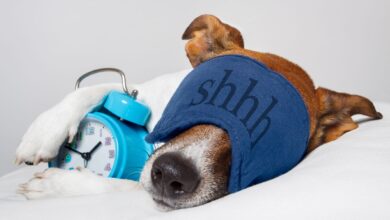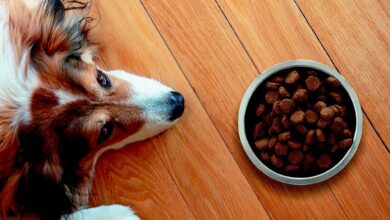Best Home Remedies for Dog Scooting – Dogster

[ad_1]
We’ve all seen it: A dog sitting on the carpet and scooting his rump across the floor. Not only is this bad for the floors — think bacteria, odor and maybe even feces and blood left behind — it’s a problem for your pooch, too. Dog scooting indicates there’s an anal issue that needs addressing. Here’s all you need to know about why dogs scoot and the best home remedies for dog scooting.
Why do dogs scoot?
The most common reason for dog scooting is from irritation around a dog’s rear end. It may be an itch, pain or a more serious problem.
This can be anything from anal gland issues, parasitic infections, skin infections around the rear or symptoms of allergies, says Dr. Gavin Casper, a certified holistic veterinarian at Hometown Animal Hospital in Weston, Florida.
Dogs also will lick and bite at their anal area and scoot across the floor if there is stool sticking to the perianal area or matted hair pulling on the area, says Dr. Judy Morgan, a certified holistic veterinarian specializing in integrative medicine and owner of Naturally Healthy Pets in New Jersey.
To effectively treat your pup’s irritated bum and eliminate dog scooting, get to the root of the problem. A trip to the vet is the best place to start. Once you know the root cause, you can decide on the best course of treatment and get your dog some relief.
Are home remedies for dog scooting safe?
Dr. Casper doesn’t recommend home remedies for dog scooting initially because they often make problems worse or mask the symptoms. However, once you’ve teamed up with your vet to address the root cause of the dog scooting, there are some safe and effective home remedies.
Root causes for dog scooting include:
- Grooming sensitivities: Trimming your dog’s hair and cleaning his perianal area may be all that’s needed to relieve irritation. Check for nicks or razor burn post grooming in case that’s causing the irritation. Research grooming products that won’t irritate a sensitive dog’s skin.
- Allergies: Allergic reactions may require some detective work to pinpoint the environmental (e.g. flea saliva, pollen and dust mites) or food irritant. After eliminating the irritant, you should notice signs of relief in your dog’s behavior. Your veterinarian is a great asset in find-the-allergen cases.
- Anal gland issues: The top culprit for dog scooting from itchy bums is anal sac (or gland) issues. In this case, Dr. Morgan says well-formed stools are the best defense. Firm stool puts pressure on the anal glands to help them empty with the pressure from the stool passing, she says.
What can I feed my dog to stop dog scooting?
For firm stools, experts say feeding dogs a high-quality diet that contains a lot of moisture and some insoluble fiber works well. Adding a high dose of fiber, such as pumpkin puree for dogs, coconut chips, ground pumpkin seed or psyllium husk, also will add bulk to the stool, Dr. Morgan says.
Canned pumpkin (pure pumpkin not pumpkin pie filling) is a very safe way to increase the digestible fiber in a dog’s diet, which has been shown to help with anal gland expression, and therefore decrease scooting behaviors, Dr. Casper says. You can find this in the grocery store or find pumpkin puree created for dogs in your local pet store, like Weruva’s Pumpkin Patch Up! or Fruitables’ Pumpkin SuperBlend Digestive Supplement.
Does Metamucil for dogs help with dog scooting?
Metamucil is a fiber supplement to help humans increase daily fiber intake. In a pinch, Metamucil for dogs is a fiber-increasing option to help firm up dog stools for natural gland expression. However, some Metamucil products contain added sugar while the sugar-free products contain aspartame, neither of which is good for dogs. Speak to your vet before using Metamucil for dog scooting to get the correct dosage for your dog, which depends on his age, health and weight.
Does Calendula help with dog scooting?
For dogs experiencing discomfort and swelling, warm compresses help. One method is a warm compress mixed with a few drops of calendula tincture.
Calendula has natural anti-inflammatory qualities, so the tincture mixed with warm compresses should decrease the discomfort, Dr. Casper says.
Other home remedies for dog scooting may offer anecdotal evidence to decrease scooting, but Dr. Casper says, “few have scientific studies to prove they work effectively and are safe.” These include Myristica, Hepar Sulph and Silicea, which “are homeopathic remedies known to decrease inflammation associated with the anal glands,” he says.
How do I know if my dog’s anal sacs are causing the dog scooting?
Anal sacs, also called glands, are two small pockets located just inside the dog’s anus; one on either side. These small sacs contain an oily fluid with a distinctive odor or scent marker that dogs use to communicate with other animals, including when stressed, afraid or pooping.
Healthy anal glands empty naturally with the passage of stool. If they become impacted, however, they may require manual expression. Signs of anal sac problems include:
- Dog scooting
- Constantly licking and biting under the tail
- Foul, fishy odor from the rectal area
- Swollen or inflamed anus
- Straining, difficult or painful bowel movements
- Blood or pus in the stool, around the rectum or where he’s been resting
- Thick, brown or gray anal sac fluid
If your dog has any of these symptoms, and especially if he has several, head to the vet ASAP. Your veterinarian will help you determine if the anal glands need to be expressed based on your dog’s history and a physical exam, Dr. Casper says. If anal glands are not expressed when needed, it can lead to diseases associated with the anal glands that can be painful.
The most common conditions dogs get from anal gland issues are impaction and abscessation. In an impacted gland, it is difficult for the glands to express so the contents harden which causes discomfort, Dr. Casper says. When anal glands become abscessed, a bacterial infection leads to pus or blood that may drain through the anal sac and can be seen on the skin or hair around the anus, he continues.
Thankfully neither condition requires surgery, experts say.
Can I express my dog’s anal glands at home?
Your dog’s anal sacs can be manually expressed by gently squeezing the delicate glands externally or internally. Some groomers include external expression as part of their service. They gently compress the outside of the sacs to push out the fluid.
Internal expression involves inserting a gloved, lubricated finger into the dog’s anus and gently squeezing each sac (finger inside and thumb outside) to empty its contents. Most dog owners let their veterinarians handle anal gland expressions. However, some intrepid dog owners take this smelly, messy task on themselves. Ask your veterinarian to show you how to do it properly if you want to take on this challenge. And, if you see blood or pus in the expressed fluid, your dog’s anal glands are infected, and he needs to see the vet.
When anal gland expression should not be done at home
Because most dogs never or rarely need anal sac expression, and because veterinarians can identify specific problems with the glands or rectum when expressing them, experts say it’s best done at the vet.
Rectal tears, bruising and trauma to the area can cause significant damage, Dr. Morgan says. And, she adds, anal glands should not be expressed just because the dog is being groomed. They should only be expressed if there is a medical need, such as impaction or abscess.
If your dog doesn’t respond to home remedies for dog scooting, diet changes, anal gland expression or combined therapies, and symptoms persist, your veterinarian might recommend anal sac removal, or anal sacculectomy. In this surgery, one or both of the anal sacs are removed, once infection and inflammation are resolved.
“Anal glands should not be removed unless they have a tumor or have chronic abscessation not resolved by diet changes,” Dr. Morgan says. “I removed less than six in 38 years of practice” she adds.
Dog scooting is unpleasant for your pooch and for you. However, armed with knowing what could be causing your dog’s discomfort, home remedies for dog scooting, and your vet’s advice, you can eliminate the unpleasantness, prevent serious issues and provide lasting relief.
[ad_2]
Source link





